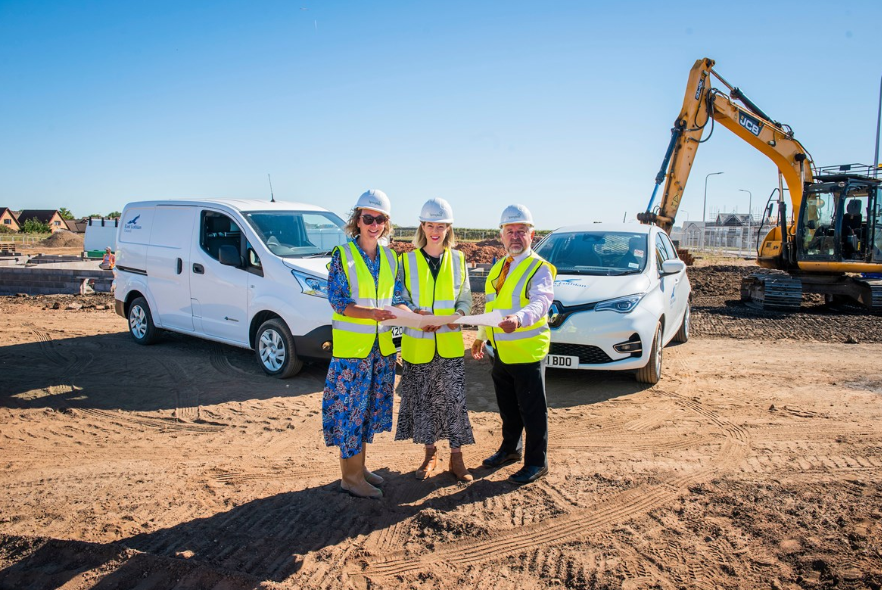New law to ensure all new buildings have electric vehicle charge points

Transport minister Jenny Gilruth joined East Lothian Council and Springfield Properties in Tranent
The Scottish Government is to introduce legislation that will ensure developers provide electric vehicle (EV) charge points in the construction of new residential and non-residential buildings.
Published as part of a summary of responses to the consultation titled ‘Scottish Building Regulations: Proposed Changes to Energy Standards Including Ventilation, Overheating and Electric Vehicle Charging Provision consultation’, the policy proposals aim to support and encourage the growing uptake of electric vehicles by ensuring that all new homes, including flats, with a dedicated car parking space are built with an electric charge point, making charging easier, cheaper and more convenient for drivers.
The new building regulations will mean that new residential buildings with a parking space have at least one EV charge point with a minimum 7kW rating. For new non-residential buildings with more than 10 parking spaces, 1 in every 10 would be expected to provide an EV charge point socket with a minimum 7kW rating. There are also requirements for residential and non-residential buildings undergoing major renovation to provide charge points.
To update the Building (Scotland) Regulations 2004, the Scottish Government will put forward secondary legislation for the consideration of the Parliament by the end of the year.
To launch the proposals, the minister for transport Jenny Gilruth joined East Lothian Council and Springfield Properties at Windygoul South in Tranent – to learn more about the work already underway to provide charge points as part of the new housing development.
Ms Gilruth said: “We know that it is important to make charging as easy as possible to help make the switch to EV. I’m pleased to confirm that we will introduce legislation to ensure all new buildings are EV enabled.
“This step will help future proof Scotland’s buildings as we transition to a net zero transport system. This supports our ambition of phasing out the need for new petrol and diesel cars and vans by 2030 as part of our response to the global climate emergency.
“We’ve already seen private developers delivering EV charge points as part of new builds in Scotland. They recognise that charge points are an attractive feature to have and offer convenience as part of a wider charging mix. These changes will provide a minimum standard that developers will need to consider going forward.
“We also know that many households will not have access to dedicated parking spaces and that’s why earlier this year we announced our £60m EV Infrastructure Fund, to ensure that all households across Scotland can be confident that EV charging will be local, accessible and that they too can switch to zero emission.”
Cllr John McMillan, East Lothian’s cabinet member for environment, economic development and tourism, said: “As we respond to the climate emergency, East Lothian Council now requires housing developers to report on how their infrastructure is mitigating climate change, and allowing new residents to adapt. Our 2018 Supplementary Planning Guidance details our expectations and we are delighted that Springfield have provided an acceptable charging provision so that this affordable housing site is equipped for the 21st Century.
“It is also our aim that every EV owner will have access to a charger on or near their usual parking place, and we engage constructively with developers to ensure their sites are capable of accommodating charging needs. We encourage innovative means of delivering chargers for everyone through features such as electrical load management.
“We have not forgotten existing residents, and continue to improve access to public chargers so that East Lothian now has one of the highest numbers of chargers per head of population in the UK.”
Tom Gibbs, Quality, environmental and sustainability manager and Springfield Properties, said: “Sustainability is at our core across the Springfield Group and we strive to do the right thing across our operations, whether it be the design of our developments, our engagement with stakeholders or in the way we look after our customers and employees.
“In 2018, when grants for electric charging points were widely available, we decided to include the cabling for electric car charging in all of our houses. With an electricity supply to the most convenient point of the house, typically by the driveway or the garage, the installation of a charging point is less intrusive for our customers for when they decide to make the switch to electric while future proofing their home. And we’re delighted that this includes our affordable development in partnership with East Lothian Council at Tranent.
“It’s great to see the Scottish Government and East Lothian Council taking further steps to enhance the electric vehicle charging infrastructure as we move towards a greener Scotland.”























